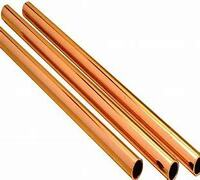1. Introduction
Copper is having a moment—and not just because it’s shiny. In the past 48 hours, the International Copper Study Group reported a sharp rise in global copper demand, fueled by massive investments in EV charging networks and solar farm grounding systems. At the heart of this boom? Products like the humble copper rod.

From electrical grounding to high-precision welding, copper rods and their cousins—strips, pipes, and bars—are foundational to modern infrastructure. Let’s break down what they are, where they’re used, and why prices are climbing.
2. What Is a Copper Rod?
A copper rod is a solid cylindrical bar made from pure or alloyed copper. Known for its excellent electrical and thermal conductivity, corrosion resistance, and malleability, it’s used across industries—from construction to electronics.
Common types include:
- Pure electrolytic tough pitch (ETP) copper rod
- Oxygen-free copper rod
- Alloyed variants like beryllium copper rod for specialized applications
You’ll often hear terms like rod copper or copper round bar—they all refer to the same basic form, just described differently depending on context.
3. Copper Rods for Earthing and Grounding
One of the most critical safety uses of copper rods is in earthing systems. A copper earth rod (also called an earthing rod copper or ground rod copper) is driven into the soil to safely channel electrical faults away from equipment and people.
While solid copper rods offer top performance, cost-conscious projects often use copper bonded earthing rods. These consist of a steel core coated with a thick layer of copper—technically called copper bonded steel—providing strength with good conductivity.
Alternatives include copper clad ground rods and copper clad steel earth rods, which use metallurgical bonding for durability. Prices vary widely based on length, diameter, and coating thickness—making earthing rod price a key consideration for contractors.
4. Copper Rods in Welding and Brazing

Not all copper rods are for grounding. In metal fabrication, copper welding rod and copper brazing rod serve very different purposes.
Copper to copper welding rods are used when joining pure copper components, especially in HVAC or plumbing. Similarly, copper to copper brazing rods create strong, leak-proof joints without melting the base metal.
For DIYers or pros alike, selecting the right copper rod for welding ensures clean, conductive, and durable connections. Terms like welding rod copper or copper rod welding might sound technical, but they simply describe application-specific consumables.
5. Copper Strips: Thin, Flat, and Versatile
When you need flat conductivity instead of round, copper strip steps in. Available as flat copper strip, thin copper strips, or even nickel plated copper strip, these are essential in busbars, transformers, and battery interconnects.
Specialty variants like beryllium copper strip or copper beryllium strip offer spring-like properties for connectors. You’ll also find copper strip roll formats for easy handling—ideal if you search for copper strip near me or roll of copper strip.
Other niche uses include copper roof strip for architectural detailing and—yes—copper tape for snails (a gardening hack to deter pests!).
For recyclers, stripping copper wire is big business. The best way to strip copper wire? Mechanical strippers. Burning copper wire for scrap is illegal in many places and releases toxic fumes. Instead, focus on fast ways to strip copper cable cleanly for resale.
Pricing fluctuates, so checking copper strip price—especially for standard sizes like 1mm copper strip or copper earth strip 25x3mm price—is smart before bulk buying.
6. Copper Pipes and Tubing: The Plumbing Backbone

Beyond rods and strips, copper pipework remains a gold standard in plumbing and HVAC. Air conditioning copper pipe (often called aircon copper tube or ac copper pipe) is prized for its durability and thermal efficiency.
Common sizes include 15mm copper pipe, 22mm copper tube, and 3/4 copper tubing. Proper bending copper pipe and copper pipe soldering techniques ensure leak-free systems.
Fittings matter too—copper pipe fittings, connectors, and copper tubing fittings must match pipe sizing. Whether you’re using 1/2 copper pipe or 2 1/2 copper pipe, compatibility is key.
With rising material costs, many compare copper vs. PEX plumbing pipes—but copper still wins for longevity and heat resistance.
7. Copper Bars: Power Distribution Essentials
Copper bar, copper flat bar, and flexible copper bus bar are workhorses in electrical panels and substations. They carry high currents with minimal loss.
You’ll see terms like cu bars, copper bars for sale, or copper ingot when sourcing raw material. Flexible copper bar options help in tight spaces where rigid bus bars won’t fit.
Pricing ties closely to the London Metal Exchange—so 1oz copper price movements affect everything from copper ingot price to copper bar top quotes.
8. Conclusion
Whether you’re installing a copper earth rod, brazing with copper to copper brazing rods, running aircon copper pipe, or recycling stripped copper wire, understanding these copper forms unlocks better decisions. With global demand surging and applications expanding into green tech, copper isn’t just a metal—it’s infrastructure.
Our Website founded on October 17, 2012, is a high-tech enterprise committed to the research and development, production, processing, sales and technical services of ceramic relative materials such as Understand. Our products includes but not limited to Boron Carbide Ceramic Products, Boron Nitride Ceramic Products, Silicon Carbide Ceramic Products, Silicon Nitride Ceramic Products, Zirconium Dioxide Ceramic Products, etc. If you are interested, please feel free to contact us.

